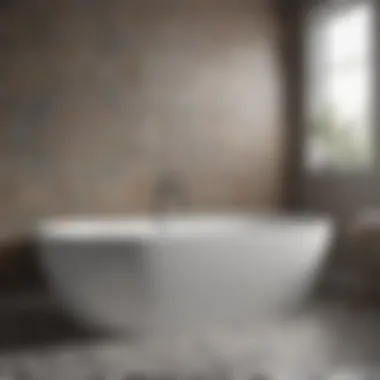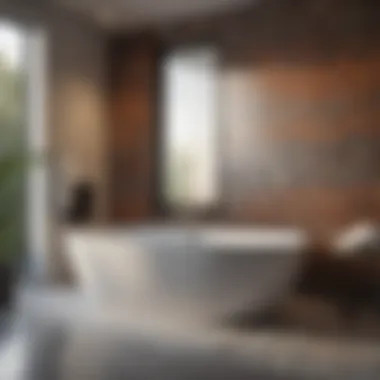Understanding Bathroom Tub Tile: A Comprehensive Guide


Intro
The bathroom is often seen as a sanctuary. Within this space, the right choice of tub tile can significantly elevate its ambiance. Understanding bathroom tub tile goes beyond just selection; it incorporates design, function, and maintenance. This guide will furnish homeowners and design enthusiasts with essential knowledge on how to choose the ideal tile, maintaining balance between aesthetics and practicality.
Design Inspirations
Incorporating well-designed tiles can transform a mundane bathroom into an impressive retreat. Articulating design inspirations helps in visualizing potential transformations.
Trending Styles
When considering styles for tub tiles, various trends can enhance your bathroom. Popular choices include:
- Subway Tiles: These provide a classic and timeless look. Easy to clean, they are versatile for various designs.
- Mosaic Tiles: Offering more creativity, these small pieces allow for intricate patterns. They work well for accent walls or floors.
- Natural Stone Tiles: Marble or granite adds a touch of luxury. However, they require more maintenance due to their porous nature.
- Large Format Tiles: These create an illusion of space, reducing grout lines and requiring less maintenance.
Color Palettes
Color selection is pivotal in conveying mood and style. Some trending palettes include:
- Cool Tones: Shades of blue and green evoke tranquility and are suitable for a spa-like feel.
- Neutral Tones: Whites, grays, and beiges remain popular due to their versatility and ability to create an open atmosphere.
- Bold Colors: Deep reds or jewel tones can serve as dramatic accents in an otherwise neutral space.
Choosing the right color can significantly impact the overall feel of your bathroom.
Product Recommendations
Selecting the right products complements your tile choices.
Bath Accessories
Consider these when enhancing functionality and style:
- Faucets: Sleek chrome or brushed nickel can match various tile styles.
- Shower Heads: A rainfall showerhead offers both luxury and practicality.
- Storage Solutions: Baskets or racks that fit the design theme can keep the area organized.
Maintenance Tools
Maintaining your tub tiles ensures longevity and appearance:
- Tile Cleaner: Select a pH-neutral cleaner to avoid damage.
- Sealant: Regular sealing for stone tiles protects against stains.
Prologue to Bathroom Tub Tile
Bathroom tub tiles serve as a critical component in both form and function within bathroom spaces. Understanding the various elements involved with bathroom tub tile can significantly affect the overall aesthetics and usability of the area. Selecting the right tile not only enhances visual appeal but also ensures durability and ease of maintenance. In this section, we will explore the definition of bathroom tub tile, as well as its importance in contemporary bathroom design.
Defining Bathroom Tub Tile
Bathroom tub tile refers specifically to the tiles installed around or within the vicinity of bathtubs. These tiles can vary in material, size, color, and texture. Common choices include ceramic, porcelain, glass, and natural stone. Each type brings unique qualities that can impact both the look and the functionality of the tub area.
Tiles used in bathrooms must be resistant to moisture and typically possess anti-slip properties. They are also often chosen for their aesthetic characteristics, depending on the desired indoor design theme. The classification of bathroom tub tile relies heavily on its application, dimensions, and the visual impression it creates in conjunction with other bathroom fixtures.
Importance in Bathroom Design
The importance of selecting the right bathroom tub tile cannot be overstated. This choice directly influences multiple aspects of bathroom design, including:
- Aesthetic Appeal: The color and pattern of tiles contribute to the overall design theme. They can create a modern look or a more traditional ambiance.
- Maintenance: Different materials have varying degrees of upkeep. For instance, glass tiles may be more prone to showing water spots compared to porcelain.
- Durability: Tiles need to endure frequent exposure to moisture and temperature variations. The right selection can help prevent issues like cracking and mildew growth.
- Value Addition: A well-tiled bathroom can enhance the property value significantly. Potential buyers often appreciate attractive and functional bathrooms.
"Investing in quality tub tiles ensures lasting beauty, function, and overall satisfaction in your bathroom space."
In summary, a thoughtful selection of bathroom tub tiles is essential not only for aesthetic reasons but also for practical considerations in daily use. With a deeper understanding of what constitutes bathroom tub tile and its role in esteemed bathroom design, readers can make informed choices that align with both functionality and style.
Types of Bathroom Tub Tile Materials
Understanding the various types of materials used for bathroom tub tiles is crucial. Each material offers distinct benefits and considerations, influencing both design choices and functional aspects. The right material not only enhances the aesthetic appeal of your bathroom but impacts durability, maintenance, and overall satisfaction with the space.
Ceramic and Porcelain Tiles
Ceramic tiles are popular for many reasons. They are durable, easy to clean, and resistant to moisture. Ceramic is made from clay, which is fired at high temperatures. This process makes it hard and robust. Porcelain tiles are a type of ceramic tile but are denser and less porous. This means they are more resistant to water and better for wet environments, such as bathrooms.


Benefits of ceramic and porcelain tiles:
- Variety: There are countless designs and colors available.
- Cost-effectiveness: Generally, they are cheaper than many natural stone options.
- Low Maintenance: They require basic cleaning and are resistant to stains.
The downside is that they can feel cold to the touch, as they do not retain heat. It is also essential to consider that some ceramic tiles may crack under heavy weight.
Natural Stone Options
Natural stone includes materials like granite, marble, and slate. Each stone is unique and adds a touch of luxury and sophistication to a bathroom. Natural stone offers a timeless look and appeals to many homeowners.
Advantages of natural stone tiles:
- Aesthetic appeal: The organic look and texture enhance beauty.
- Longevity: With proper care, natural stones can last a lifetime.
However, natural stone requires regular sealing to prevent water absorption. This makes them less favorable in terms of maintenance. They can also be more expensive than ceramic or porcelain tiles, and may not be as slip-resistant when wet.
Glass Tiles
Glass tiles are striking and modern. They come in various colors and finishes, reflecting light and creating an illusion of space. These tiles can be used alone or combined with other materials for a unique design.
Key features of glass tiles include:
- Stain resistance: Glass does not absorb water or stains, making cleaning easier.
- Visual appeal: The reflective surface adds brightness and depth, ideal for small bathrooms.
The primary drawback is that glass tiles can be slippery when wet, so caution in choosing the right type for a bathroom is necessary. They can also be more fragile than other materials, and installation may require skilled labor to avoid breakage.
Vinyl and Laminate Alternatives
Vinyl and laminate tiles offer an affordable option for those on a budget. They mimic the look of more expensive materials while providing ease of installation and maintenance. Vinyl tiles are waterproof and come in sheets or tiles, offering flexibility for various designs.
Benefits include:
- Cost-effective: Much cheaper than natural stone or high-end ceramics.
- Easy installation: Many homeowners can install these themselves.
- Comfort: Vinyl is softer underfoot compared to harder materials.
However, these materials may not add significant value to a home. Over time, they may wear down or discolor, especially in high-traffic areas.
"Choosing the right tub tile materials involves a balance between aesthetics, functionality, and budget considerations."
In summary, explore various bathroom tub tile materials to find what fits best for your needs. Consider not only the visual aspects but also the functional requirements and maintenance expectations.
Design Considerations for Tub Tiles
Choosing the right tiles for your bathroom is crucial, as they contribute both to the aesthetics and functionality of the space. This section will dive into the key design considerations for tub tiles, including color schemes, textures, and sizes. Elements such as these can create a harmonious environment or clash, influencing the overall feel of your bathroom.
Color Schemes and Patterns
Color is one of the first aspects people notice in any bathroom. Selecting a color scheme that aligns with your personal style and the overall atmosphere you want to create is essential. Consider the emotional effects of colors; for example, blues and greens typically evoke a sense of calm, while brighter colors can make a space feel vibrant and energetic.
In addition to solid colors, integrating patterns can enhance the visual interest of the tiles. Geometric shapes or floral motifs can add character to the bathroom. When selecting patterns, ensure they complement the overall design goal. Striking a balance between bold patterns and subtle hues can create depth without overwhelming the senses.
Texture and Finish Choices
Texture is not merely for appearance; it plays a vital role in functionality and safety. Smooth tiles are elegant but can be slippery, particularly when wet. Hence, choosing textured surfaces can offer better grip, reducing the risk of accidents.
Having a mix of finishes also adds richness. For example, matte, polished, and honed finishes can coexist in a single design scheme, providing varying reflections and depths. Such diversity invites tactile interactions and an engaging aesthetic experience within the space. Remember, textures can dramatically change the atmosphere. A rough, natural stone finish may impart an earthy feel, while sleek glass tiles suggest modern sophistication.
Size and Scale of Tiles
Tile size is another design consideration that can affect the perception of space. Larger tiles can make a small bathroom feel more expansive by reducing the number of grout lines. However, smaller tiles may provide more detail and customization, allowing for unique designs.
The scaling of tiles should be proportionate to the size of the bathroom and tub. Large tiles may look out of place in compact areas, while small tiles in spacious bathrooms can get lost visually. When determining the appropriate tile size, consider the layout, natural light, and any architectural features.
"Embracing various design considerations can transform your bathroom from plain to extraordinary, enhancing both comfort and style."
Ultimately, paying careful attention to color, texture, and size can ensure that your selected tiles enhance the space functionally and aesthetically. This attentiveness will help create a bathroom that not only meets practical needs but also fosters enjoyment in everyday use.
Installation Techniques for Tub Tiles


Proper installation techniques for bathroom tub tiles ensure the longevity and aesthetic appeal of your bathroom. Understanding these methods is a valuable aspect of this comprehensive guide. It can save homeowners from common pitfalls and expensive repairs down the road. A successful installation not only enhances visual charm but also ensures water-resistance and durability, key factors in any bathroom setting.
Pre-Installation Preparation
Before any tiles are placed, thorough preparation is crucial. First, assess the area where the tiles will be installed. Make sure the surface is clean, dry, and free from any debris. It is essential to repair any damage to the underlayment or wall, as imperfections can lead to uneven tiling.
Next, gather the needed materials. Preparing your space minimizes future disruptions. Create a layout to determine the tile pattern and cuts. This step allows for a more efficient process once the actual installation begins. Accurate planning reduces the likelihood of wasting materials or needing additional trips to the store.
Methods of Installation
There are several methods to consider when installing tub tiles, each with its own advantages. Here are some popular techniques:
- Thin-Set Mortar: This is a widely used method for installing ceramic and porcelain tiles. Thin-set mortar allows for a strong bond and is relatively easy to work with. It is ideal for both wall and floor tiles.
- Mastic Adhesive: Mastic is a premixed adhesive, mostly suitable for dry areas. It is easier to apply than thin-set but not recommended for wet conditions due to its water-soluble nature.
- Submerged Installation: This technique involves applying tiles in areas that will constantly be in contact with water. Specialized adhesives are required for this approach.
Each method has its own application requirements and suitability based on the chosen tile and location. Careful consideration of these factors will lead to a more durable and attractive finish.
Tools Required for Installation
Having the correct tools on hand can make the installation process smoother. Here are some necessary tools:
- Tile Cutter: To achieve precise cuts, a tile cutter is essential. You may opt for manual or electric models, depending on project size.
- Notched Trowel: This tool helps spread adhesive evenly across the surface, facilitating a strong bond between the tile and substrate.
- Level Tool: Ensuring that the tiles are installed evenly is crucial for a professional appearance. A level tool helps monitor this.
- Grout Float: This tool is used to apply grout between the tiles once installed, ensuring proper filling and a polished finish.
- Spacers: Tile spacers provide consistent spacing, preventing tiles from shifting and ensuring uniform grout lines.
Using these tools will not only ease the installation process but will also enhance the overall quality of the work done. Having the right equipment is as important as knowing the methods.
Maintaining Bathroom Tub Tiles
Maintaining bathroom tub tiles is crucial for both aesthetics and functionality. A well-maintained bathroom not only enhances the overall appearance but also contributes to the longevity of the tiles. Regular upkeep helps to prevent the accumulation of dirt and grime, which can lead to more significant issues over time. This section focuses on the various aspects of maintaining bathroom tub tiles, including effective cleaning routines, addressing grout problems, and strategies to prevent damage.
Regular Cleaning Routines
Establishing a regular cleaning routine is one of the most important aspects of maintaining bathroom tub tiles. Daily cleaning can help to keep tiles looking fresh and free from soap scum.
Recommended Steps for Cleaning:
- Daily Wipe Down: Use a soft cloth or sponge to wipe down tiles after each bath or shower. This prevents the build-up of moisture that can lead to mold.
- Weekly Deep Clean: Once a week, use a pH-balanced cleaner designed for tiles. Avoid harsh chemicals that can damage the surface.
- Rinse Thoroughly: After applying cleaners, rinse the tiles with water to remove any residue. This is important for maintaining the finish and preventing discoloration.
Benefits of Regular Cleaning:
- Prevents mold and mildew growth.
- Keeps tiles looking new longer.
- Reduces the need for intensive cleaning later.
Dealing with Grout Issues
Grout maintenance is often overlooked but is vital for the integrity of bathroom tiles. Over time, grout can become stained or discolored. If not addressed, this can lead to more serious issues, such as water damage or mold growth.
Key Strategies for Grout Maintenance:
- Regular Sealing: Apply a grout sealer every six months to a year. This helps to protect against stains and moisture infiltration.
- Stain Removal: For stained grout, consider using a specialized grout cleaner or a mixture of baking soda and vinegar. Apply it to the stains and scrub gently with a brush.
- Replacement Considerations: If grout is extensively damaged or moldy, replacing it might be necessary. This ensures that tiles remain securely in place and prevents water issues underneath.
"Regular attention to grout can prolong the life of your bathroom tub tiles significantly."
Preventing Damage and Wear
Preventing damage and wear is essential to maintaining the beauty and functionality of bathroom tub tiles. Certain practices can help avert common issues that arise over time.
Preventative Measures Include:
- Use Soft Materials: Avoid cleaning pads or brushes that can scratch the surface. Opt for soft sponges or cloths instead.
- Control Humidity: Excess humidity can lead to mold growth and tile deterioration. Use exhaust fans during and after showers to mitigate moisture.
- Manage Temperature Changes: Sudden temperature changes can cause tiles to crack. Be mindful of hot water sources near your tiles, and avoid rapid heating and cooling.
By considering these aspects, homeowners can effectively maintain their bathroom tub tiles, ensuring a clean and appealing space for years to come. Regular cleaning, addressing grout concerns, and taking preventive measures are all essential to the overall upkeep of your bathroom's tile surfaces.
Budgeting for Bathroom Tub Tile Projects
Budgeting is critical when planning a bathroom tile project. Having a clear financial framework helps to navigate choices and avoid overspending. Understanding the overall costs associated with bathroom tub tiles can guide homeowners in making informed decisions that fit their aesthetic goals and practical needs.
Cost of Materials
When considering tile options, the cost of materials can differ widely. Factors contributing to the price include the type of tile chosen, size, and pattern intricacies. For instance, ceramic tiles often range from $1 to $5 per square foot, while natural stone tiles can go from $5 to $30 per square foot, depending on the stone type. Some glass tiles may even exceed $30 per square foot. It’s essential to factor in other elements like grout and adhesive, which can add to the total material expenses.


It's wise to research options thoroughly. Look for sales, buy in bulk, or consider alternative materials that mimic the desired look at a lower price point. Always seek product samples when possible to assess quality and visual compatibility before making a bulk purchase.
Labor Expenses
Labor costs represent a significant portion of any tile project. Rates can range based on regional averages, the tile's complexity, and the installation technique required. Basic installations may cost between $5 and $10 per square foot for labor alone, while intricate designs or intricate stone patterns might escalate to $15 per square foot or more.
When budgeting, consider whether to hire a professional or take a DIY approach. While professional services ensure quality and adherence to best practices, undertaking the project oneself can present both personal satisfaction and savings. However, the learning curve can lead to costly mistakes. Therefore, weighing skill level against potential risks is crucial.
Long-Term Value Considerations
Investing in high-quality bathroom tub tiles is often wise. Durability and maintenance should be evaluated over time. Higher initial costs can translate to years of reduced maintenance and replacement. For example, porcelain tiles are highly resistant to moisture and wear, making them a good long-term investment. This approach extends to aesthetic trends, as classic designs typically retain value over time.
Consider the potential for increased home resale value. Homes with well-renovated bathrooms can attract buyers and justify a higher price. In a sense, quality bathroom tiles are not just an immediate expense but can be viewed as a long-term investment contributing to future financial benefits.
Investing in quality tiles may save you in the long run by reducing replacement and maintenance costs, while enhancing your bathroom's aesthetic appeal.
Current Trends in Bathroom Tub Tile
Understanding the latest trends in bathroom tub tile is crucial for anyone looking to enhance both aesthetics and functionality in their bathroom spaces. The contemporary bathroom design landscape reflects a growing emphasis on sustainability, technology integration, and nostalgic aesthetics. Having knowledge of these trends equips homeowners and design enthusiasts with the insights needed to make informed decisions that can transform their bathrooms into stylish retreats.
Sustainable and Eco-Friendly Factors
The rise of environmental consciousness has influenced many areas, including home design. In recent years, sustainable materials have gained popularity in bathroom tub tile. These tiles often come from recycled or responsibly sourced components, minimizing environmental impact.
Benefits of sustainable tiles include:
- Reduced carbon footprint
- Longer lifespan reducing the need for replacements
- Innovative designs without compromising style
Materials such as recycled glass or sustainably harvested wood are common examples. When utilizing eco-friendly tiles, homeowners can maintain a chic design while contributing positively to the environment.
Smart Bathroom Features
Technology has found its way into the bathroom, influencing tile trends significantly. Smart bathroom features integrate with tiles to enhance user experience. For example, some tiles can incorporate heating elements to provide a warm surface underfoot.
Considerations include:
- Temperature control: The comfort of a heated tile can enhance relaxation during baths.
- Water-resistance: Smart tiles are often designed with advanced coatings that repel water, reducing the chances of mold or mildew.
- Lighting integration: LED tiles can provide ambient lighting, creating an inviting atmosphere in the bathroom.
These features not only elevate the aesthetic appeal of the space, but also offer practical benefits that cater to modern lifestyles.
Vintage and Retro Styles
Amid the trend towards modernity, vintage and retro styles are making their comeback in bathroom design. Homeowners increasingly seek to evoke nostalgia through the use of classic tile patterns and colors.
Key attributes of these styles are:
- Use of bold colors and intricate patterns, reminiscent of the mid-20th century.
- Classic materials such as ceramic or encaustic tiles that bring historical charm and character.
This trend resonates with those who appreciate the aesthetics of bygone eras. It allows spaces to tell a story while remaining stylish.
"Incorporating vintage tiles not only adds uniqueness but also celebrates craftsmanship and design history."
As the world of design continues to evolve, staying informed about these trends can inspire thoughtful decisions. The blend of sustainable practices, smart technology, and classic elements create a rich tapestry of choices in bathroom tub tile that can meet both functional needs and personal style.
Culmination
In evaluating the overall relevance of bathroom tub tiles, it becomes clear that their role extends beyond mere aesthetics. They serve as a critical component in enhancing both the functionality and the visual appeal of a bathroom. It is essential to approach the conclusion with a focus on the key points gathered throughout the article. The insights provided about the types of tiles, design considerations, installation methods, and maintenance protocols collectively shape the understanding on how best to select and utilize these tiles.
Summarizing Key Insights
When considering bathroom tub tiles, several important aspects come to light:
- Material Selection: Ceramic, porcelain, glass, and natural stones each offer unique benefits and styling options. Understanding the characteristics of these materials aids homeowners in making informed choices.
- Design Elements: Choosing colors, patterns, and textures requires attention to how they integrate with the overall bathroom theme. This influences not only the appearance but also the impression of space and cleanliness.
- Installation Practices: Proper installation is vital for longevity and performance. Familiarity with various installation methods ensures a more durable and appealing result.
- Maintenance Routines: Regular upkeep can extend the life of the tiles. Knowing the best practices for cleaning and maintenance will preserve both function and aesthetics.
"Good choices in tub tiles enhance the comfort and efficiency, fostering a sanctuary within the home."
Final Thoughts on Choosing Tub Tiles
In the end, selecting the right tub tiles is an investment in a home's functionality and ambiance. Homeowners should prioritize quality over price, considering the long-term implications of their choices. Remember to assess not just immediate preferences, but how particular tiles will age and complement future design changes.
Moreover, taking time to research current trends and innovations can yield surprising results. As we advance into eras focused on sustainability and smart technologies, embracing these elements can further improve the bathroom experience.
Ultimately, it is advisable for homeowners to balance personal tastes with practical requirements. Understanding the nuances of bathroom tub tiles paves the way to a space that is both beautiful and functional. This careful blend of aesthetics and utility results in a bathroom that welcomes relaxation and enjoyment.



